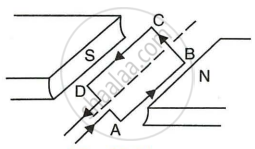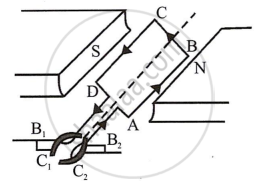Advertisements
Advertisements
प्रश्न
A coil ABCD mounted on an axle is placed between the poles N and S of a permanent magnet as shown in Figure.

- In which direction will the coil begin to rotate when current is passed through the coil in direction ABCD by connecting a battery at the ends A and D of the coil?
- Why is a commutator necessary for continuous rotation of the coil?
- Complete the diagram with commutator, etc. for the flow of current in the coil?
उत्तर
- The coil begins to rotate in anticlockwise direction.
- This is because, after half rotation, the arms AB and CD get interchanged, so the direction of torque on coil reverses. To keep the coil rotating in same direction, commutator is needed to change the direction of current in the coil after each half rotation of coil.

APPEARS IN
संबंधित प्रश्न
Which of the following correctly describes the magnetic field near a long straight wire?
Observe the following figure:

If the current in the coil A is changed, will some current be induced in the coil B? Explain.
The magnetic field lines in the middle of the current-carrying solenoid are?
(a) circles
(b) spirals
(c) parallel to the axis of the tube
(d) perpendicular to the axis of the tube
For Fleming's left-hand rule, write down the three things that are 90° to each other, and next to each one write down the finger or thumb that represents it.
A current-carrying conductor is placed perpendicularly in a magnetic field. Name the rule which can be used to find the direction of force acting on the conductor.
In the simple electric motor of figure given below, the coil rotates anticlockwise as seen by the eye from the position X when current flows in the coil

Is the current flowing clockwise or anticlockwise around the coil when viewed from above?
If the current in a wire is flowing in the vertically downward direction and a magnetic field is applied from west to east, what is the direction of force in the wire?
When current is parallel to a magnetic field, then force experience by the current-carrying conductor placed in a uniform magnetic field is ____________.
What does the direction of thumb indicate in the right-hand thumb rule. In what way this rule is different from Fleming’s left-hand rule?
Which of the following pattern correctly describes the magnetic field around a long straight wire carrying current?
